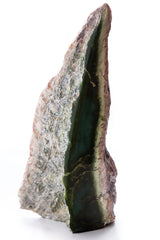Pounamu - the Stone, the Legend

Formed in the depths. Delivered by water.
While Pounamu is only found in a limited number of South Island sites, these locations are nothing short of spectacular. From the area surrounding the Taramakau and Arahura Rivers in the northern part of Westland, to coastal South Westland, the Lake Whakatipu area and Fiordland, the chief Pounamu deposits are found in some of the most scenic parts of New Zealand.
The Taramakau River reaches the ocean between Hokitika and Greymouth, north of the Arahura River. The township of Kumara, once a flourishing gold-mining centre, is located on its southern bank. It has been noted that gold diggers often found pounamu boulders in the same areas where they searched for gold. Many of those were sold but who knows how many more stones and boulders could lie hidden under old gold tailings?
The Arahura jade field has supplied both Māori and Pākehā with thousands of tonnes of top quality pounamu and is known for its dark kawakawa stone. Any pounamu found in this area since 1997 is owned by the Mawhera Incorporation, which has the sole right to harvest it.
In South Westland, nearly all the rivers from the Jackson River to Big Bay have produced jade. This region boasts some of New Zealand’s most beautiful, most remote and most rugged terrain and much of it is under the protection of National Park conservation laws. Given the evidence in unearthed artefacts, it is believed Māori discovered pounamu in this area very early in their history here. A number of early European explorers also noted the presence of small, isolated settlements where Māori worked greenstone.
The Cascade River runs through the Cascade Plateau. Te Rūnanga o Ngāi Tahu has never given permission to outside parties for the collection and sale of the distinctive pounamu from this region. The first time this treasured Tahutahi (snowflake) pounamu was legally used was when it was carved into 380 pounamu pendants by Hokitika carver, Jeff Mahuika for New Zealand’s London Olympic team.
The Stone
Authentic New Zealand Pounamu tells stories of pride and understanding, strength, empathy and leadership. No two pieces are the same, no stone not treated with the utmost respect by those who source and carve it.
Renowned for its beauty and strength, the rare stone is highly valued by both Māori and greater New Zealand. While generically known as ‘greenstone’ Pounamu refers to the particular types of hard nephrite jade, bowentine or serpertine found in southern New Zealand.
With the strong spiritual connection Māori have with the stone a number of different stories and characteristics have been bestowed on the stone and it’s wearers over the generations.
This is just one of the reasons why Pounamu is described as taonga, or treasure, by those who know its qualities.
Pounamu has a diverse range of colours with a myriad of variations in colour and pattern combination. The strong spiritual connection Māori have with pounamu is reflected in the way the various stone types were named with - each pounamu type being given an identity that corresponded to the world Māori lived in. The stone was named after native birds, fish and plants. Others are linked to pakiwaitara or storytelling and others linked to specific locations.
Endless combinations of pounamu types occur, ranging from the yellow/orange enriched tones of flower jade to the rich green and white tinted snowflake jade. No two pieces of pounamu are the same, guaranteeing every carving is unique to you and your loved ones.
The Legend
She was taken from the sea. He was run into the ground.
This tale of a taniwha named Poutini and his taking of Waitaiki has been passed down by generations. Ngāi Tahu children grew up knowing of Tamaahua and his pursuit of his wife down through the islands. They learned how this legend shaped the natural environment, and why we cherish and protect our resources today.
He roimata tuturu
“My sorrow has been left in the stone”
Poutini the taniwha swims up and down the west coast of the South Island, protecting both the people and the mauri of Pounamu.
Many of the oral histories of Pounamu revolve around Poutini coming across a woman bathing in the northern seas of the Bay Of Plenty. This beautiful woman, Waitaiki, enchanted the taniwha, who kidnapped her and fled south with his prize.
Waitaiki’s husband, the chief Tamaahua, discovered she was missing. Aided by a tekatekahe tracked them south. During Poutini’s flight the taniwha lit fires to keep Waitaiki warm. Amidst the charred remains of each fire, Tamaahua found precious stone.
The continued pursuit of his love was determined and unrelenting. Fearing the strength of his pursuer the taniwha took sanctuary on the West Coast of the South Island, eventually stopping in Milford Sound.
Realising that Tamaahua would not rest until he reclaimed Waitaiki, Poutini decided the only way to keep her forever was to turn the woman into his essence. The taniwha transformed Waitaiki into Pounamu, laid her in down within the riverbeds of the Arahura River and slipped downstream past the waiting Tamaahua.
When the chief discovered his wife turned to stone in the riverbed he let out a tangi - a tremendous song of grief. If you listen closely in New Zealand’s deep south you may still hear it echo through the mountains.
 is here! Shop now, pay later in 4 easy installments
is here! Shop now, pay later in 4 easy installments
